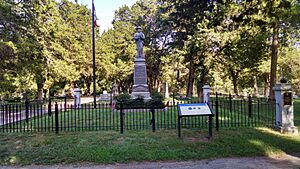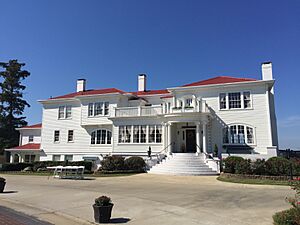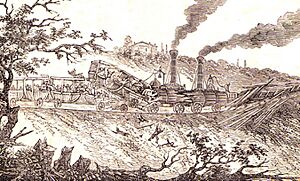History of Suffolk, Virginia facts for kids
Suffolk, Virginia, is a city in the southeastern part of Virginia, located in the Hampton Roads area. Long ago, this land was home to Native American tribes. When Europeans first arrived, the Nansemond people lived along the river that now shares their name. The area was first explored by colonists from Jamestown in 1607. These early settlers, led by explorer John Smith, were looking for ways to survive in their new home.
Contents
The Nansemond People and Early Settlers
The Nansemond tribe lived in this area for a very long time. By 1584, they had four villages along the Nansemond River, especially near a place called Chuckatuck, which is now part of Suffolk. Their main chief lived near Dumpling Island, where their important temples and sacred items were kept. At that time, the tribe had about 1,200 people, including 300 skilled bowmen.
In 1608, John Smith and other colonists from Jamestown explored the Nansemond River. They were looking for oyster beds. When they found a Nansemond village, Smith's group raided it. This made the relationship between the colonists and the Nansemond people much worse. The next year, Nansemond warriors attacked another group led by Smith. In return, Smith's men raided the tribe's temple. Even with these problems, the new colony grew quickly. Settlers soon took control of the land, pushing the Nansemond people out. The Nansemond tribe lost their last official reservation lands in 1792.
How Suffolk Began and Grew
The area that is now Suffolk was first part of Elizabeth River Shire in 1634. Then, in 1637, it became part of Upper Norfolk County, which later changed to Nansemond County in 1646.
In the 1720s, a man named John Constant settled along the Nansemond River. He built a home, a dock, and a warehouse. This place became known as "Constant's Warehouse." In 1730, a law called the Tobacco Inspection Act said that one of the 40 official tobacco warehouses should be at "the widow Constance's" at Sleepy-Hole Point in Nansemond County.
In 1742, the House of Burgesses, which was Virginia's government at the time, approved a new town at Constant's Wharf. They named it "Suffolk" after Sir William Gooch, who was the Royal Governor. His home county in England was also called Suffolk.
By 1750, Suffolk became the main town for Nansemond County. Many enslaved Africans were brought to the area. They worked on ships, as skilled workers, and most importantly, on tobacco plantations. Their hard work was very important for the area's success in exporting tobacco. Some enslaved people managed to escape to the nearby Great Dismal Swamp and joined communities of free people living there.
During the American Revolutionary War, in 1779, the British army burned Suffolk. The town was completely destroyed when thousands of barrels of turpentine and pitch in warehouses along the river caught fire.
Suffolk During the Civil War
Suffolk officially became a town in Nansemond County in 1808. When the American Civil War began, Virginia, including Suffolk, joined the Confederacy.
From May 1862 to July 1863, about 25,000 Union soldiers occupied Suffolk. Their leader was Major General John J. Peck, who made his headquarters in a house now called "Riddick's Folly." You can still see drawings and writings on the walls left by soldiers and prisoners from that time.
During this period, Confederate General James Longstreet led about 20,000 soldiers to surround the town from April 11 to May 4, 1863. He was trying to gather supplies for the main Confederate army. During the siege, another Confederate general, George Pickett, would secretly leave to meet his sweetheart, LaSalle (Sallie) Ann Corbell, who later became his wife. General Robert E. Lee eventually ordered Longstreet to leave Suffolk and rejoin the army near Fredericksburg. Two months later, on July 3, the Union forces also left Suffolk for strategic reasons.
Confederate cavalry general Laurence S. Baker is buried in Suffolk's Cedar Hill Cemetery.
The Importance of Peanuts in Suffolk
In 1912, an Italian immigrant named Amedeo Obici moved from Pennsylvania and opened factories for the Planters Nut and Chocolate Company in Suffolk. He chose Suffolk because many farmers in the area grew peanuts. By 1941, Suffolk was known as "The Peanut Capital of the World."
The city also became home to Planters' famous advertising character, Mr. Peanut. In 2004, Mr. Peanut was voted the third most popular advertising icon in the country! There is a statue of Mr. Peanut in downtown Suffolk. The Planters company, now owned by Kraft Foods, is one of the largest employers in Suffolk.
In 1924, Amedeo Obici and his wife Louise lived at Bay Point Farm in Chuckatuck, overlooking the Nansemond River. Their home is now a Virginia Historic Landmark and belongs to the City of Suffolk. To honor his wife, Obici donated money to build the Louise Obici Memorial Hospital in Suffolk, which opened in 1951. A newer hospital, Obici Sentara Hospital, opened in 2002.
For many years, the local AM radio station WLPM had call letters that stood for World's Largest Peanut Market. Today, Suffolk is still a very important center for processing peanuts.
Suffolk and the Railroad
Because Suffolk was a gateway to Norfolk and Portsmouth, it became a major hub for railroads. Many of Virginia's railroads passed through Suffolk at different times.
Before the American Civil War, both the Portsmouth and Roanoke Railroad and the Norfolk and Petersburg Railroad were built through Suffolk. These were early versions of today's large Class 1 railroads, like those operated by CSX Transportation and Norfolk Southern. Other railroads, such as the Atlantic Coast Line Railroad, the Atlantic and Danville Railroad, and the Virginian Railway, also built lines through Suffolk on their way to the harbor at Hampton Roads.
The 2008 Tornado
On April 28, 2008, a very strong tornado moved through parts of Suffolk. This tornado was one of the most powerful to hit Virginia in recent history. It was also the worst tornado to strike Hampton Roads since a tornado caused by the remains of Tropical Storm Dennis nine years earlier. The 2008 tornado was rated EF3 on the Enhanced Fujita Scale, which means it caused significant damage.




